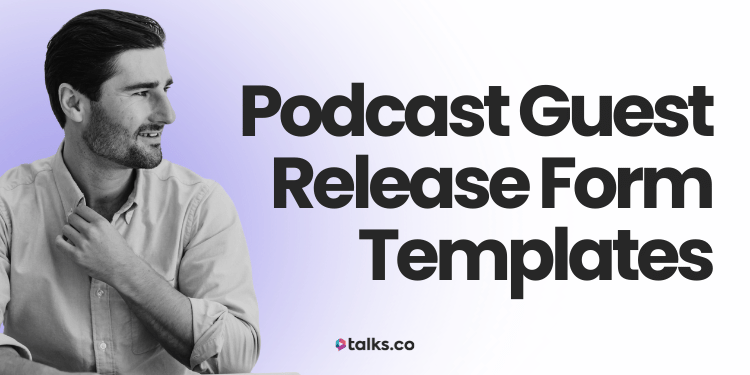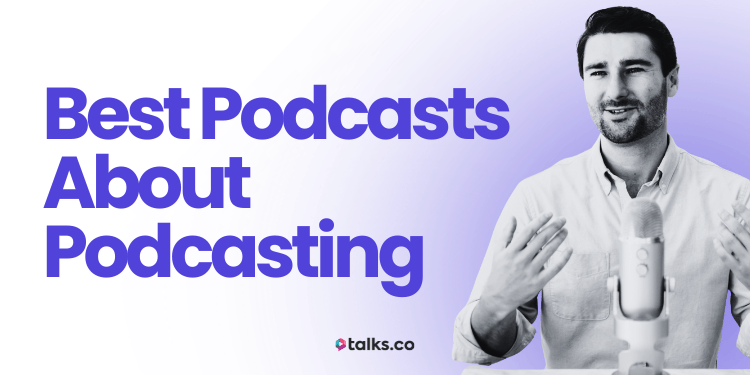What if planning your next podcast episode actually felt easy?
You sit down to record. No second-guessing your podcast topic. No scrambling for podcast ideas. You already know how to make your podcast episode flow.
A unique podcast opener, a standout moment in the middle, a punchy wrap-up, and maybe a surprise podcast content or two that keeps your audience engaged the whole way through.
That’s the power of having solid podcast segment ideas.
If you’re a podcast host, coach, author, speaker, or entrepreneur chasing more new listeners and credibility, this list is for you. I’ve pulled together 45 podcast segment ideas you can borrow, remix, or totally run with.
And the best part? You don’t need a production team or years of experience to make your new content feel sharp, clear, and memorable.
You just need a bit of inspiration and the right kind of structure.
Come check this out.
What Is a Podcast Segment?

A podcast segment is a fun way to engage your audience with a clear role to play like a quick tip, a listener question, a guest story, or even a fun wildcard bit you drop in each week.
A podcast segment can help break an episode up into more consumable chunks that actually make sense. Instead of one long ramble, you’ve got a few key parts that keep things moving and help keep listeners engaged.
Segments help you:
- Keep your episodes tight and on track.
- Mix things up without losing your flow.
- Build structure without sounding stiff or scripted.
The best part?
Once you lock in a few go-to segments, planning your podcast segment outline becomes way easier. Your listeners know what to expect, and you’ve got a great podcast rhythm that works.
30 Podcast Segment Ideas with Real Examples
Picture kicking off your show the way a great match starts: clear game plan, quick touches, crowd leaning in.
The different podcast segment ideas below are your playbook. Steal one, mix a few, or swap a part of your podcast each week; whatever type of segment keeps your listeners on their toes and you in control of the flow.
1. Quick-fire Q&A kickoff

Open the episode with a burst of listener questions. You read each one, set a tight timer, and answer on the spot. Short, sharp, high-energy.
The Tony Robbins Podcast often has a show segment with rapid listener questions answered in quick succession, creating an engaging and fast-moving intro podcast format.
Why it works:
- Hooks listeners in the first minute.
- Builds instant audience involvement.
- Sets a lively tone before the deeper topic ideas.
2. Listener mailbag

A segment for your podcast dedicated to reading and responding to questions, comments, and hot takes your audience sends in. Think of it as opening the locker room door and letting the crowd step right onto the pitch.
Signals From the Deep answers listener questions on hockey, road life, and JT’s take on potato salad in episode 28.
Why it works:
- Builds real community when your listeners hear their names and feel part of the show.
- Gives you ready-made talking points (no last-minute scrambling).
- Sparks fresh ideas for future episodes.
Ask for podcast interview questions at the end of every episode and pin a submission link at the top of your show notes. Collect them through the week, pick three to five that fit your theme, and keep each answer under two minutes so the pace stays snappy and is easy for listeners to digest.
3. Expert hot seat
Bring in a guest as part of your show to solve one specific problem your audience cares about. No bios, no backstories, just straight into the challenge. Think of it like dropping them into the match with the ball already at their feet.
Online Marketing Made Easy puts experts on the spot to tackle focused marketing questions listeners want answers to.
Why it works:
- Keeps the conversation sharp, relevant, and action-packed.
- Shows your audience what’s possible when someone with real skill steps in.
- Makes guests look good and makes you look smart for bringing them in.
Frame the challenge clearly before your guest jumps in. Keep it tight, aim for 10-15 minutes max, and wrap it with one takeaway your audience can try themselves.
4. Myth or fact?
Call out a common belief in your niche and break it down: is it legit or just hype? You’re basically refereeing the truth and your listeners are watching closely.
Huberman Lab tackles big health claims and sorts science from nonsense, like whether ice baths really boost recovery.
Why it works:
- Gives your audience clarity on stuff they’re probably wondering about.
- Positions you as someone who knows your stuff (and isn’t afraid to say it).
- Easy to rinse and repeat as a regular segment.
Use a strong hook to set it up (“You’ve heard this a hundred times… but is it actually true?”), then back it with facts, stories, or your own take. Aim for one clear verdict by the end.
5. Rapid research recap
Break down a fresh study, headline, or statistic in plain English. Think of it like halftime analysis: fast, clear, and straight to the point.
Maintenance Phase digs into health trends and studies, explaining the research behind wellness fads without all the jargon.
Why it works:
- Makes you the go-to for “what’s actually going on” in your space.
- Keeps your content current and conversation-worthy.
- Builds trust with your audience by showing you’ve done your homework.
Skim the study beforehand, pull one statistic or claim that stands out, and use it to open the segment. Keep the pace snappy, like you’re sharing it with a friend who’s just curious, not a room full of experts.
6. Success story snapshot
Shine a light on someone who’s had a win, big or small, and break down what helped them get there. It’s like a quick highlight reel with a behind-the-scenes replay.
The School of Greatness by Lewis Howes regularly shares inspiring success stories from guests and listeners to motivate and educate.
Why it works:
- Builds trust and credibility through proof, not hype.
- Inspires listeners without dragging out a full case study.
- Gives you a chance to celebrate your audience or community.
Keep it under two minutes, focus on what made the result possible, and always bring it back to something your listener can try or take away.
7. Coach’s corner
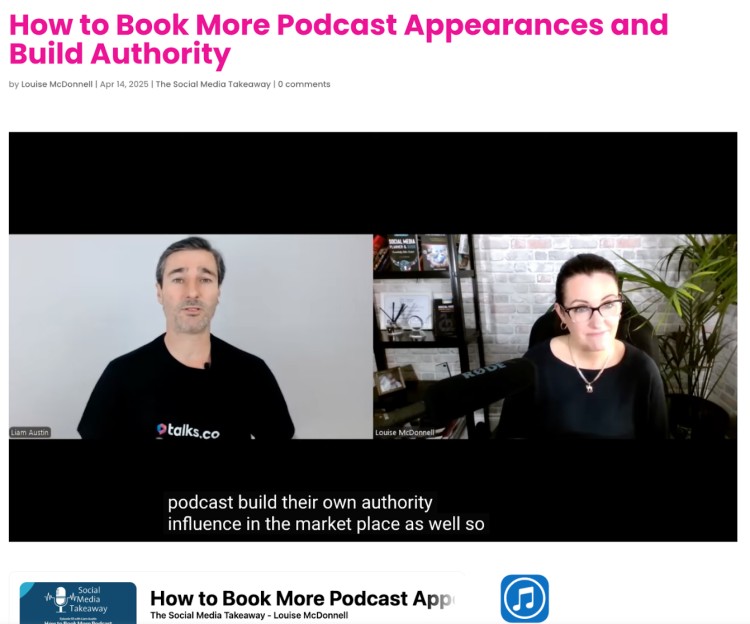
A segment where you share quick, practical coaching tips or advice like having a mini coaching session right in your episode. It’s a chance to give listeners something they can apply immediately, straight from the sidelines.
In an episode I did for The Social Media Takeaway with Louise McDonnell, I share my secrets to leveraging social media to grow your podcast that I’d normally only share during my masterminds.
Why it works:
- Positions you as an expert who delivers value consistently.
- Offers bite-sized advice easy to remember and use.
- Keeps listeners coming back for regular insights.
Keep it short, focused, and actionable like a little coaching boost in each episode.
8. Tactical tip of the week
This segment delivers a practical, hands-on tip listeners can apply immediately. The kind of advice that cuts through theory and gets straight to action. Think of it like sharing your best move from the playbook to help your audience win at whatever they’re tackling.
The Tim Ferriss Show often includes actionable tips that listeners can test out and see results from.
Why it works:
- Gives your audience clear, usable takeaways every episode.
- Builds your authority as someone who knows the game inside out.
- Encourages listeners to try new strategies and come back for more.
Keep your tip sharp and practical. It should feel like a quick assist your listeners can use right away.
9. Book bite breakdown
Pick a key insight, story, or lesson from a book relevant to your niche and break it down in a short, digestible segment. It’s like sharing the highlight reel of a great read that your audience can benefit from without having to turn a single page.
The Minimalists Podcast often shares takeaways from books about simplicity and intentional living.
Why it works:
- Positions you as someone who stays on top of valuable knowledge.
- Gives your audience curated, time-saving wisdom.
- Sparks interest in books and ideas that support your message.
Keep each breakdown focused and punchy; just enough to spark curiosity and inspire your audience to explore more if they want.
10. Trending news tackle
Jump on a recent headline, trend, or hot topic related to your podcast’s focus and give your take on it. Think of it as stepping onto the pitch right after the whistle, ready to call the plays on what’s happening right now.
The Daily by The New York Times regularly breaks down current events with clear commentary and insight.
Why it works:
- Keeps your show current and relevant.
- Positions you as someone in tune with your industry.
- Sparks listener engagement through timely discussions.
Make sure to add your unique perspective to keep things interesting and avoid just repeating the headlines.
11. Case study spotlight
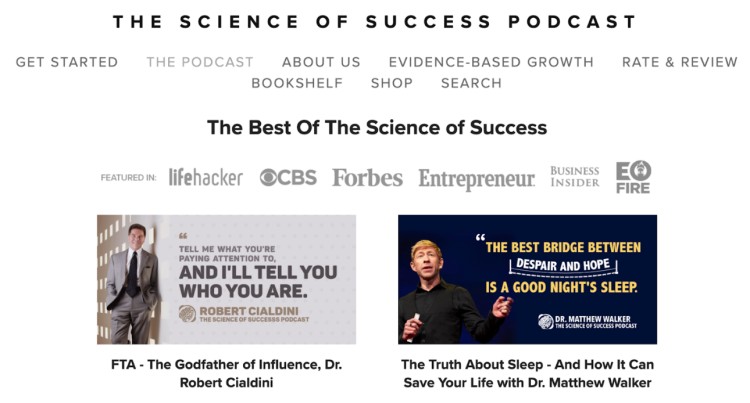
Dig into a real-life example that highlights a win, a lesson, or a smart move relevant to your audience. It’s like reviewing the game tape to see what worked, what didn’t, and how to score next time.
The Science of Success podcast often features deep dives into case studies that break down how people and organizations achieve their goals.
Why it works:
- Shows practical application of ideas or strategies.
- Builds credibility with real-world proof.
- Gives listeners a clear story to relate to and learn from.
Pick stories that connect with your audience’s goals and struggles. Keep it clear, detailed, and focused on the takeaway.
12. Mistake to mastery
Share a blunder, setback, or misstep. Then walk through how you or someone else turned it around into a win. It’s like showing the replay of a missed shot, then the training that made the next goal inevitable.
The Ed Mylett Show often features guests talking about failures they faced and how those moments shaped their success.
Why it works:
- Makes you relatable by showing you’re human.
- Turns failures into valuable lessons.
- Encourages listeners to keep pushing through setbacks.
Highlight the growth process. It’s all about turning mistakes into steps forward.
13. Collaboration call-out
Invite guests, influencers, experts, or even your podcast listeners to contribute ideas, fun facts, stories, or questions for upcoming episodes. It’s like passing the ball to your team and getting everyone involved in the game.
Why it works:
- Builds engagement and community.
- Generates fresh content ideas.
- Makes your audience feel involved and valued.
Wrap up episodes and include a call to action to send in ideas and feature the best contributions to keep momentum going.
14. Scholar vs. practitioner debate
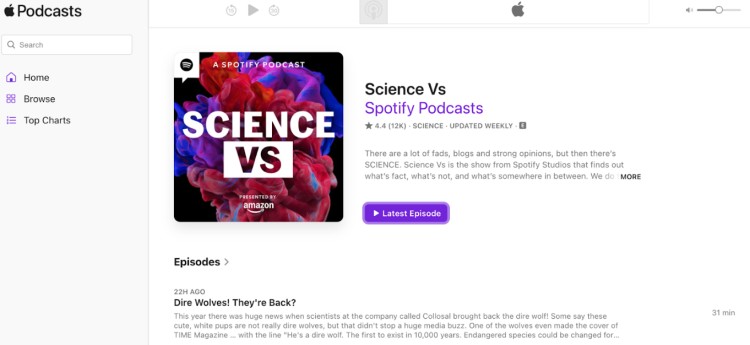
Set up a friendly clash between theory and real-world experience. Pit a researcher, expert, or academic against a hands-on practitioner to discuss a hot topic or controversial idea in your field. It’s like a midfield battle where both sides push for control, but the audience gets to decide the winner.
The Science Vs podcast often uses this approach, breaking down myths and facts with experts and real-life examples.
Why it works:
- Brings fresh perspectives and lively discussion.
- Makes complex topics easier to understand.
- Encourages listener engagement and critical thinking.
Invite podcast guests who respect each other’s views but aren’t afraid to challenge them. Keep it respectful but spirited for the best listener experience.
15. Two-minute mindset reset
A quick, focused segment where you guide listeners through a brief mindset shift or mental refresh. Think of it as halftime; a moment to regroup, refocus, and come back stronger.
The Mindset Mentor podcast often has one segment for short mindset boosts to help listeners reset during their day.
Why it works:
- Provides immediate value with actionable mental shifts.
- Fits easily into any episode as a regular pause.
- Helps build a positive, motivating vibe.
Keep it simple and authentic. A couple of minutes is all you need to help listeners reset and keep moving forward.
16. Tool time
Dedicate a segment to showcasing a specific tool, app, or resource that helps your audience tackle a problem or boost their skills. Think of it as handing out the perfect cleat to get the best kick.
The Productivity Show often features “tool time” segments highlighting apps and gear to get things done faster.
Why it works:
- Gives practical, actionable recommendations.
- Builds trust as you share what really works.
- Keeps content fresh and useful.
Keep it honest and hands-on. Your audience will appreciate real-world tips they can try immediately.
17. Start of the day
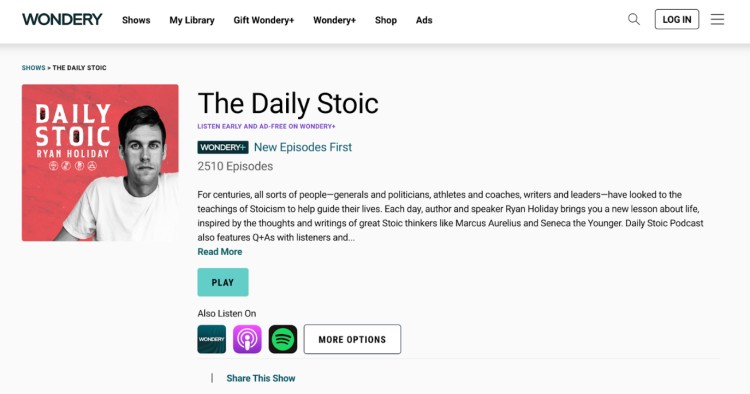
Kick off your episode with a quick routine, thought, or habit that sets the tone for the day. It’s like the pre-game warm-up that gets your listeners ready and focused.
The Daily Stoic podcast has a wellness podcast segment on their show dedicated to short reflections or stoic quotes designed to ground listeners and prepare them mentally for the day ahead.
Why it works:
- They bring value and create connections by sharing daily wisdom.
- Great way to help listeners pause and reflect.
- Sets a calm, thoughtful tone for the episode.
Keep it short and meaningful. A simple way to help your audience set the right tone for their day.
18. Pitch practice
Give yourself (or your guest) a short window to pitch an idea, product, or concept, then break it down together. It’s like a speed drill for persuasion skills. Think Shark Tank but not as long.
You can feature entrepreneurs delivering real startup pitches to a panel of investors, followed by live feedback.
Why it works:
- Helps guests sharpen how they talk about their work.
- Gives listeners insight into effective (and not-so-effective) pitches.
- Adds a dynamic, high-stakes feel to your episode.
Keep it playful, fast, and insightful and don’t forget to set a timer.
19. Thought leader throwdown

Pick two strong, differing takes from respected voices in your space and pit them against each other. Respectfully, of course. You break it down, add context, and share your take.
Pivot with Kara Swisher and Scott Galloway often features sharp, opposing views on tech, media, and business trends.
Why it works:
- Creates tension and contrast that keep your listeners engaged.
- Positions you as someone who stays across the latest debates.
- Encourages critical thinking for complex podcast topics (not just echo chambers).
Make sure the segment involves both sides to get a fair shake and use it as a springboard for a thoughtful, original perspective.
20. Behind-the-scenes peek

Give listeners a glimpse into what really goes on behind the mic, the scenes, or the strategy. Share the wins, the slip-ups, and the stuff they’d never see on your highlight reel.
Office Ladies with Jenna Fischer and Angela Kinsey gives fans insider stories from filming The Office, from wardrobe malfunctions to cast pranks.
Why it works:
- Makes your show (and brand) feel human and relatable.
- Great way to increase deeper connection with loyal listeners.
- Adds texture and storytelling depth to even everyday good podcast topics.
You don’t need a full expose. Just one honest peek behind the curtain can make the whole episode feel fresh and real.
21. Resource round-up
A curated list of tools, links, books, or episodes you’ve found useful lately all in one place. It’s like handing your listeners a cheat sheet they’ll want to save and share.
Why it works:
- Makes your audience feel like insiders getting your personal picks.
- Encourages binge listening or further learning.
- Works well for solo or guest episodes alike.
End the segment with your final thoughts and invite listeners to share their own go-to resources for a chance to be featured in the next round-up.
22. Viral clip commentary
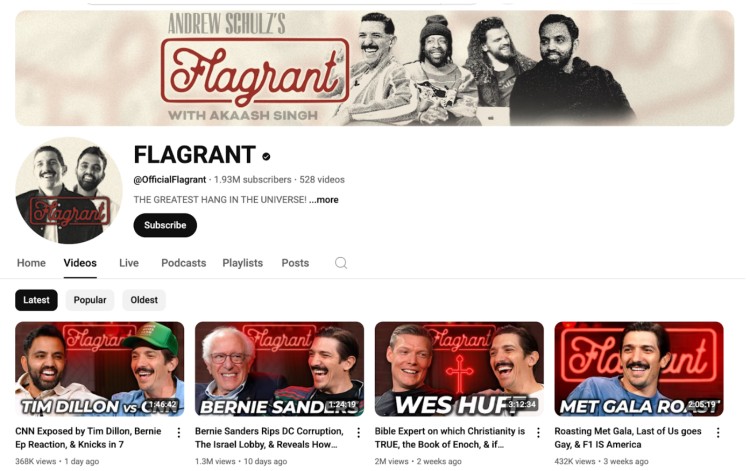
Break down a trending video, quote, or moment that’s blowing up and add your own take. It’s part reaction, part analysis, and a great way to tap into what people are already talking about.
Flagrant regularly riffs on viral sports moments, celeb clips, and internet chaos, blending hot takes with humor and insight.
Why it works:
- Keeps your podcast fresh and relevant.
- Gives your audience your unique lens on a moment they already care about.
- Encourages listener engagement and debate.
Pro tip: Keep clips under 60 seconds and always give credit. Use screen/audio grabs where allowed, or describe the moment in vivid detail before jumping into your take.
23. Origin story moment

Share a defining moment that shaped who you are or how you work whether it’s the stroke of genius that led you to start your business, a massive failure you learned from, or the weird twist that brought you to where you are now.
The Diary Of A CEO often features these moments, like when guests open up about the real turning points in their journey.
Why it works:
- Builds trust by showing your human side.
- Gives your audience something to relate to.
- Makes your brand more memorable and personal.
Keep it raw and real. No need to wrap it in a bow. A few minutes of honest storytelling can stick with people way longer than polished advice.
24. Win, lose, or draw (soccer-style lessons)
Break down a recent win, a tough loss, or something that didn’t go to plan and share the lesson behind it. Doesn’t have to be dramatic. Even a minor hiccup can teach something worth passing on.
The High Performance Podcast often weaves in these kinds of lessons with elite athletes and coaches.
Why it works:
- Makes your experience relatable without pretending you’ve got it all figured out.
- Reinforces your credibility through lived examples.
- Adds story-driven variety to your content.
Keep it conversational. Think: what would you share with a friend after the match, pint in hand? That’s the tone.
25. Audience challenge
Throw down a fun, practical challenge your listeners can take on before the next episode. Keep it simple, doable, and tied to your topic. Something they can try in real life, then report back on.
The Lazy Genius Podcast regularly gives listeners mini challenges to try out new routines, simplify decisions, or focus on what matters most.
Why it works:
- Boosts engagement and gives your listeners a reason to come back.
- Makes your content feel actionable and interactive.
- Builds momentum as your audience starts stacking wins.
Make it easy to say “yes” then follow up next episode with listener shoutouts, results, or funny stories that came from it.
26. Hot take lightning round
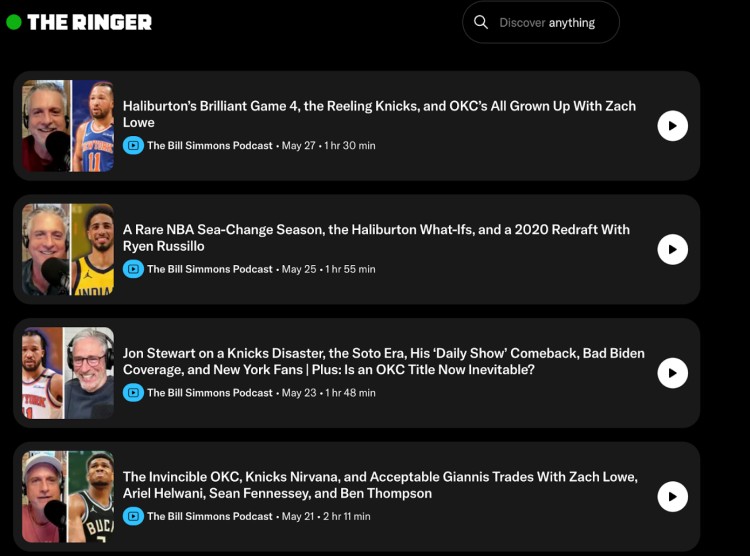
Rapid-fire opinions on trending topics, myths, or common beliefs in your niche. Think quick, bold, and maybe a bit controversial delivered with energy to keep listeners hooked.
On The Bill Simmons Podcast, Bill and guests often drop quick takes on sports news and pop culture in lightning-fast bursts.
Why it works:
- Keeps the energy high and the pace snappy.
- Shows your personality and strong viewpoints.
- Sparks conversations and debate among listeners.
Keep each take under 30 seconds to maintain momentum and encourage listener reactions.
27. Quote and context
Share a standout quote tied to your show’s theme, then break down why it matters. It’s a simple way to pack a punch with few words.
How I Built This with Guy Raz kicks off episodes by quoting founders or innovators, then explores the story behind those words.
Why it works:
- Quickly grabs attention.
- Connects ideas to real-world examples.
- Gives listeners a takeaway to chew on.
Keep it tight and use the quote as a launchpad for your episode’s main message.
28. Rant relief
Let loose on a topic that’s been grinding your gears whether it’s a common industry pet peeve or a frustrating trend. Rants show your personality and keep your show real.
The Joe Rogan Experience often features Joe’s candid rants on everything from media hype to cultural trends.
Why it works:
- Shows your authentic voice.
- Connects with listeners who share your frustrations.
- Breaks up more serious or scripted content.
Keep it passionate but punchy. Two to five minutes is enough to get the point across without losing your audience.
29. Future forecast
Look ahead and share your predictions or hopes for what’s coming next in your field. It’s a great way to spark curiosity and keep listeners thinking beyond the now.
Exponential View with Azeem Azhar dives into how technology and society might evolve in the near future.
Why it works:
- Positions you as forward-thinking and informed.
- Encourages listeners to stay engaged with emerging ideas.
- Opens the door for follow-up episodes and updates.
Keep your forecast realistic but optimistic, and invite listeners to share their own predictions for added interaction.
30. Rapid reflection wrap-up
End your episode with a quick, thoughtful recap that highlights key takeaways or lessons learned. It’s like the final whistle, wrapping everything up clearly and memorably.
Mind Shift with Erwin & Aaron McManus often closes episodes with a brief reflection that sums up the main points.
Why it works:
- Reinforces your message.
- Helps listeners remember the episode’s value.
- Leaves your audience with something to think about.
Keep it short, punchy, and personal to maintain that connection with your audience right to the end.
Radio Segment Ideas vs Podcast Segment Ideas
Radio and podcasts share the same core goal: keeping ears glued. But the playing fields are different.
- Live vs. on-demand: Radio runs in real time with fixed clocks, traffic hits, and ad breaks. Podcasts drop when you’re ready and let listeners choose their own kickoff.
- Broad reach vs. niche depth: Terrestrial radio aims for the biggest local audience it can snag in a single sweep. Podcasts target tighter communities and can dive deeper without worrying about drive-time tune-outs.
- Strict timing vs. flexible flow: A radio breakfast show might need a three-minute traffic update at 7:15 sharp. A podcast can stretch or shrink a segment to fit the story, not the clock.
- Regulated content vs. creative freedom: FM hosts follow licensing rules, profanity limits, and music quotas. Podcasters have fewer guardrails (though audience expectations and platform policies still apply).
- Passive callers vs. active listeners: Radio relies on quick call-ins and texters. Podcasts can use social polls, email, or community groups to gather questions and stories ahead of time as part of your podcast content strategy, letting you polish them for the episode.
Bottom line: Borrow the energy and structure radio perfected, then use podcast flexibility to make each segment sharper, deeper, and more personal.
Radio segment examples
Traditional radio runs on fast-paced, clock-driven segments that keep listeners engaged between songs, ads, and news breaks. Here are a few classic formats that have stood the test of time:
- Call-in advice hour: Listeners phone in with problems or questions, and the host offers live guidance.
- On this day in history: A quick look back at notable events that happened on the same date in past years.
- Trivia showdown: A fast-paced quiz where callers compete for prizes or bragging rights.
- Celebrity news roundup: A quick-fire gossip update, often mixed with opinion and banter.
- Traffic and weather updates: Timely reports on road conditions and local forecasts, delivered in short bursts.
Good Segments for a Podcast (Checklist)
Not every type of podcast idea deserves a recurring spot on your show. Use this checklist to decide whether a segment earns a place in your rotation:
- It adds value: Listeners leave with a tip, a laugh, or a fresh perspective.
- It fits your style: The segment sounds like you, not a copy of someone else.
- It’s repeatable: You can run it weekly or monthly without it going stale.
- It invites engagement: Listeners can submit questions, vote, or share their own stories.
- It keeps things moving: The pace stays tight and doesn’t drag.
- It’s flexible: You can tweak the format based on your topic or guest.
- It makes the edit: You’re not constantly cutting it because it failed to land.
Hit at least five of these seven, and you’ve likely found a winner.
Good Ideas for Podcast Segments
There’s endless inspiration and podcast interview tips out there, but the best segments match your style and your audience. Below are genre-specific ideas that make a good podcast.
Sports podcast segment ideas
Sports podcasts work best when they blend analysis with personality. These segment ideas can help you strike that balance and keep your listeners coming back for more.
- Post-match rewind: Break down the latest game. What worked, what didn’t, and the biggest talking points.
- Transfer watch: Weekly updates on player moves, trade rumours, or draft buzz.
- Tactics explained: Analyze one key play, move, or strategy in plain language.
- Fan questions: Tackle hot listener takes and dive deep.
- Legend spotlight: Highlight a retired player and their lasting impact.
Comedy podcast segment ideas
Comedy podcasts thrive on rhythm and surprise. These segment formats can help you stay consistent without losing that off-the-cuff energy.
- Bad advice hotline: Listeners send problems, you give deliberately awful (and funny) solutions.
- Petty gripe of the week: Exaggerate the smallest annoyance for maximum laughs.
- What’s in the news?: Pick a ridiculous headline and riff on it.
- Character cameo: Bring on a recurring fake persona for a rant or sketch.
- Unpopular opinion court: A guest defends a questionable take while you play judge.
Funny podcast segment ideas
If your show leans funny but isn’t fully in the comedy category, these segments let you inject funny podcast questions and humor without scripting an entire bit.
- Embarrassing story time: Hosts or listeners share cringe-worthy moments.
- Fake sponsor ads: Perform over-the-top commercials for obviously non-existent products.
- Weird internet finds: Review a bizarre Amazon product, meme, or comment thread.
- Two lies and a truth: Flip the classic game for comedic effect.
- Overheard this week: Share the strangest thing you overheard in real life.
Shape Your Show
You’ve now got 30 solid podcast segment ideas plus the tips to make each one sing. Pick two or three that fit your style, run them next episode, and see how your audience reacts.
Rotate, refine, repeat.
Soon you’ll have a format that feels both fresh and reliable.
Of course, great segments need ears. Talks pairs you with shows and hosts who want the expertise you already have, so you spend less time pitching and more time talking to the right crowd.
Want your segments tested on real listeners, not buried in your Notes app?
Create Your Free Talks Profile and start lining up guest spots today.

